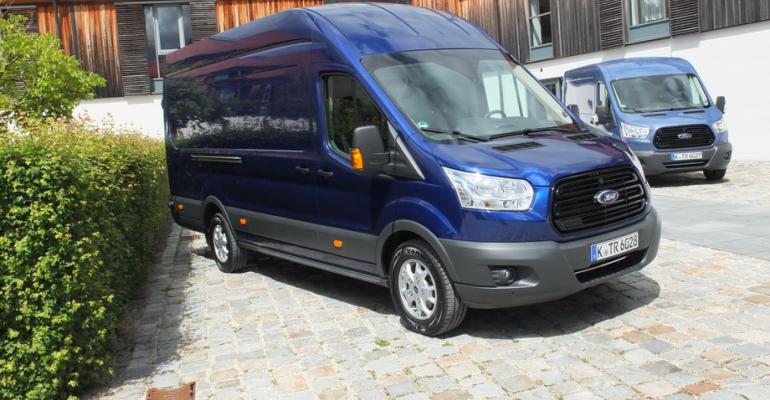MUNICH – Ford unveils new versions of its Transit 2-ton and Transit Custom vans powered by the all-new, downsized 2.0L EcoBlue turbodiesel engine developed by the same engineering team responsible for the successful Ecoboost gasoline mill.
The EcoBlue TDCi is compliant with Euro VI emissions standards taking effect in Europe in September, using selective catalytic technology to reduce oxides of nitrogen emissions 55% from existing Euro V standards. Ford says the Transit Custom with the optional start-stop feature produces 157 g/km of carbon dioxide, down from 182 g/km in the current 2.2L TDCi model.
The EcoBlue is assembled in the same Dagenham, U.K., plant where the EcoBoost engine is built and has undergone 3.4 million miles (5.5 million km) of testing by Ford. Another 250,000 miles (402,500 km) later were driven by Transit customers for everyday use.
“The new engine has been developed with the latest turbocharging, fuel injection, combustion system, structural design and low-friction technologies to deliver significant improvements in fuel efficiency, performance and operating refinement, while delivering the outstanding durability and low cost of ownership demanded for a Transit power unit,” the automaker says.
The 2.0L EcoBlue engine will be offered for Transit 2-ton and Transit Custom models, in 105-, 130- and 170-hp power ratings, each of which offers increased power and torque compared with the outgoing 2.2L engine.
Operating costs of the new Transit vans drop as periodic maintenance intervals are extended to two years or 37,000 miles (60,000 km). Fuel consumption in different versions of the Transit Custom range from 36.2-39.2 mpg (6.5-6.0 L/100 km), and from 24.2-34.1 mpg (9.7-6.9 L/100 km) in different Transit 2 iterations.
“EcoBlue engine offers improved low-end pulling power, with 20% more torque at 1,250 rpm, delivering more flexible and responsive performance in everyday driving,” Ford says.
EcoBlue Slated for Cars, But Not in U.S.
Antonio Chicote, commercial-vehicles manager-Ford Iberia, says the power range will be extended to 200 hp and even 230 hp in the future, as the new EcoBlue engine is earmarked for use in some future Ford car models.
“Unfortunately, EcoBlue engines will not be exported to the U.S., as motorists there are not used to diesel engines and prefer (gasoline) ones,” Chicote says.
A new SelectShift 6-speed automatic transmission will be offered later this year for the front-wheel-drive versions of both new vans, a feature Ford engineers believe will appeal to motorists mainly driving in urban areas.
The Transit Custom van comes with a choice of two body lengths and two roof heights, although the crew-cab van will be available only in the lower roof height. Cargo volume ranges from 212-293 cu.-ft. (6.0-8.3 cu.-m) with a payload capacity between 1,390 and 3,260 lbs. (630 and 1,480 kg). The model will be offered in four body versions: van, crew-cab van, CUV seating five or six and Kombi seating eight or nine.
The larger Transit 2-ton’s cargo volume ranges from 293-533 cu.-ft. (8.3-15.1 cu.-m), with a payload capacity ranging between 1,600 and 4,600 lbs. (725-2,065 kg). It will offer front-, rear- and all-wheel-drive versions and will be available in five body lengths and two roof heights. Transit 2-ton configurations comprise pure van, crew-cab van, CUV, Kombi, chassis cab, chassis with crew-cab and minibus.
Some of the driver-assistance technologies used in Ford cars migrate to the new-generation Transit models. For example, the pre-collision assistant with pedestrian detection uses cameras and radar to reduce the severity of some frontal collisions involving vehicles and pedestrians, or help drivers avoid some impacts altogether.
Offered as options are Adaptive Cruise Control using forward-facing radar to maintain a set distance from the vehicle ahead, and Traffic Sign Recognition that provides the current detected speed limit, cancellation signs and passing restrictions via the instrument-cluster display.
An upgraded Electronic Stability Control system, standard on both new vans, improves vehicle stability in extreme driving situations using three Ford-patented features: Side Wind Stabilization, a new system that applies the brakes on one side of the vehicle to reduce the effect of a sudden side wind gust on the vehicle’s path; Curve Control, designed to slow the vehicle when it enters a curve such as an exit ramp too quickly and Roll Stability Control, designed to help prevent rollover by controlling both engine torque and individual wheel braking.
Inside the cabin, Transit customers can specify Ford’s SYNC 2 voice-activated connectivity system with a new high-resolution 6-in. (15.2-cm) color touchscreen, featuring advanced voice control of audio, navigation and mobile phones. Standard on Transit Custom vans is a 4‑in. (10-cm) color display that replaces the 3.5-in. (8.9-cm) screen on vehicles equipped with the existing SYNC system.
The vans are assembled in Kocaeli, Turkey, by Ford Otosan, a joint venture between Ford and local industrial group Koc Holdings, and went on sale earlier this month.





